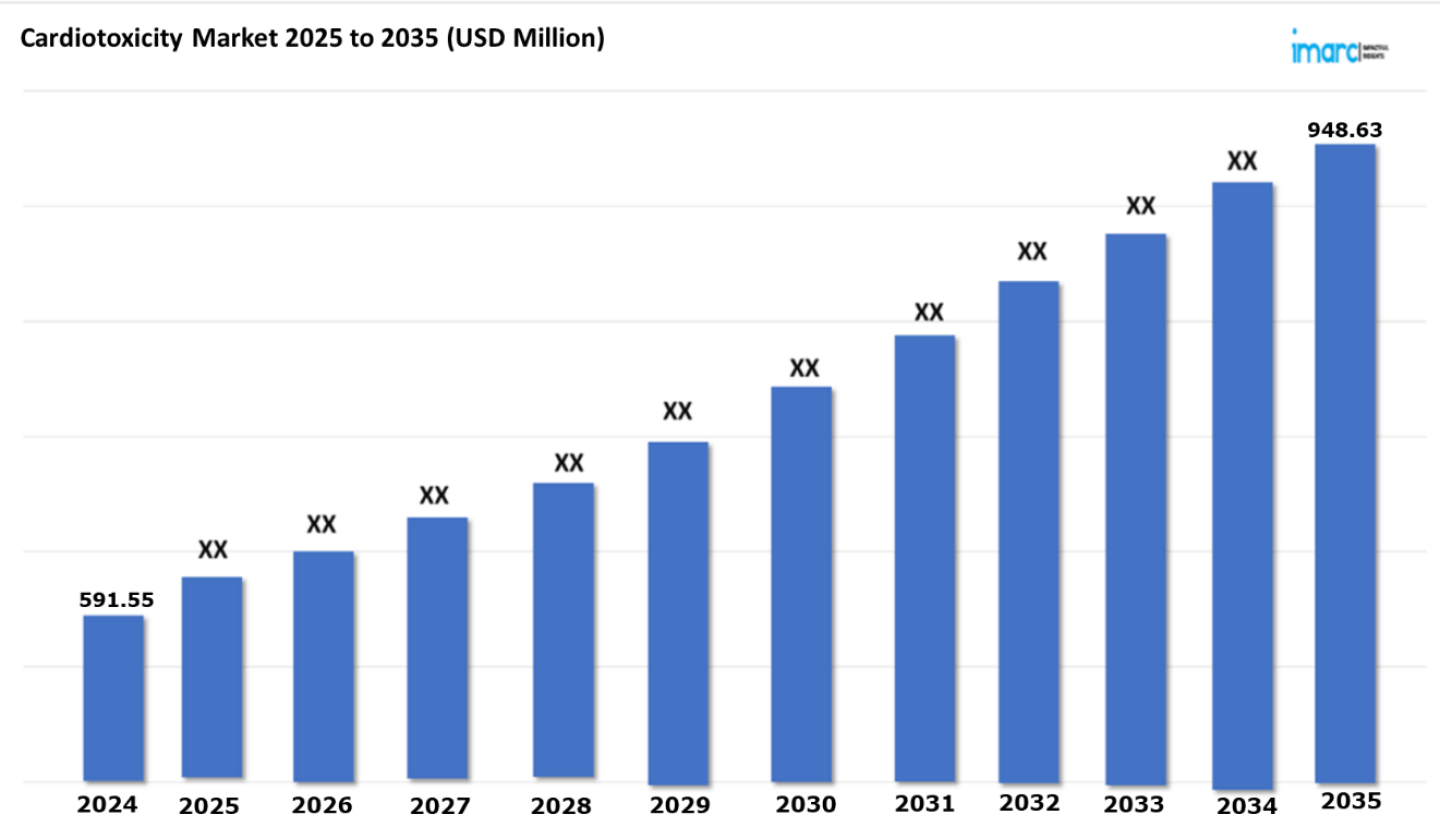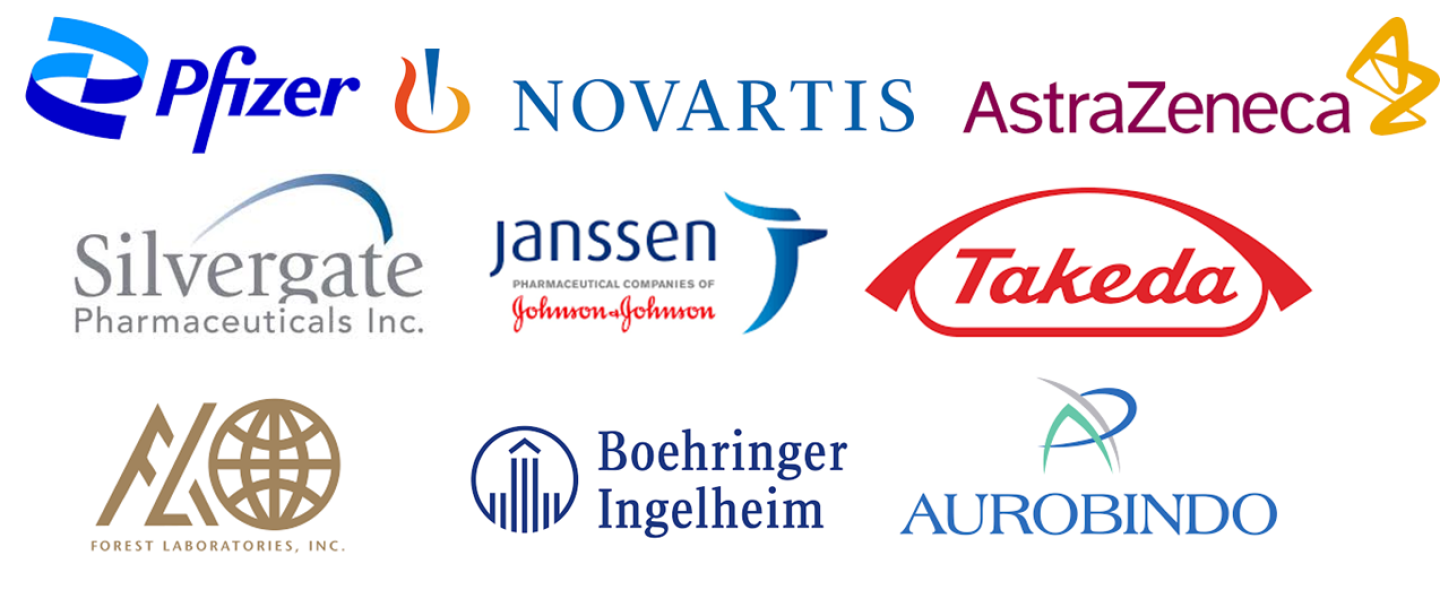Cardiotoxicity Market Outlook 2025-2035:
The 7 major Cardiotoxicity market reached a value of USD 591.55 Million in 2024. Looking forward, IMARC Group expects the 7MM to reach USD 948.63 Million by 2035, exhibiting a growth rate (CAGR) of 4.37% during 2025-2035. The cardiotoxicity market is growing rapidly, driven by increasing heart disease incidence and the cardiac side effects due to cancer therapy. With chemotherapy and targeted therapies being known to induce cardiac complications commonly, there is a need for helpful and very effective ways of detecting, monitoring, and treating such cases. All developments that involve the latest diagnostic tools, including biomarkers and imaging options, are bound to boost this expanding market. A greater opportunity is also opened for drug developers and clinicians with the introduction of new drugs and with increasing awareness of cardiotoxicity in clinical practice. The market also draws traction from personalized medicine studies in susceptible patient populations.
Surge in Heart Disease Incidents: Driving the Cardiotoxicity
Increased incidences of heart diseases are largely responsible for the rising focus on the cardiotoxicity market. Cardiotoxicity refers to a state of compromised heart functioning in general due to treatments such as chemotherapy or the administration of certain medications. The growing incidence of cardiovascular diseases worldwide is now presenting another dimension of concern along with heart health, which gets increasingly burdened with anticancer demands. Increasing incidences of heart disease widen the risk window for patients who may suffer from cardiotoxic effects induced by therapy concerning cancer treatment, his in turn is driving the demand for better monitoring, early detection, and preventative strategies for cardiotoxicity. The healthcare system is under high pressure to integrate cardiac management into cancer therapy regimens, recognizing the double burden of cancer and heart disease. Furthermore, with the increased burden of heart disease, there will be more impetus for the pharmaceutical industries to discover and develop drugs with reduced cardiotoxic effects. Researchers are also looking for other safer options in treatment, thus leading to innovative drugs that target both cancers and the heart. This awareness of cardiotoxicity has prompted regulators to enforce strict safety protocols. Patients, healthcare providers, and the pharmaceutical industry are increasingly prioritizing cardiovascular protection. The expansion of cardiotoxicity research is expected to improve the overall survival rate of cancer patients and minimize heart-related complications.
Request a PDF Sample Report: https://www.imarcgroup.com/cardiotoxicity-market/requestsample
Development of Novel Therapies and Pharmacological Treatments: Contributing to Market Expansion
The development of novel therapies and pharmacological therapies for cardiotoxicity have become the key catalysts paving the way for the market’s growth. Improvements in pharmacology, in particular the development of cardioprotective drugs and precision medicine, are enabling individualized regimens through which heart-related side effects associated with cancer treatments and other medications lessen. There is also a strong push towards discovering biomarkers for early diagnosis and creating personalized treatment strategies, which is driving innovation. Promising new approaches like gene therapy, stem cell treatments, and proteomics are emerging as potential solutions for repairing heart damage. As awareness of cardiotoxicity rises alongside the global increase in cardiovascular diseases, the demand for such therapies continues to grow. Regulatory agencies are expediting the approval of therapies for such issues, which also increase the market. Even more importantly, the growth in research funding and partnerships between pharmaceutical companies and academia in research is accelerating developments in the area, increasing the cardiotoxicity treatment market.
Buy Full Report: https://www.imarcgroup.com/checkout?id=7394&method=809
Marketed Therapies in Cardiotoxicity Market
Dexrazoxane: Novartis
Dexrazoxane is an intravenous cardioprotective agent used to mitigate the cardiotoxic effects of anthracycline chemotherapy. By chelating iron, it reduces oxidative stress and helps prevent heart damage without compromising the anticancer efficacy of anthracyclines. This protective medication is particularly beneficial for patients at high risk who need extended anthracycline therapy.
Drug Name | Company Name | MOA | ROA |
Dexrazoxane | Novartis | Iron chelating agents | Intravenous |
Detailed list of marketed and emerging therapies in Cardiotoxicity is provided in the final report…
Leading Companies in the Cardiotoxicity Market:
The market research report by IMARC encompasses a comprehensive analysis of the competitive landscape in the market. Across the global Cardiotoxicity market, several leading companies are at the forefront of developing integrated platforms to enhance the management of cardiotoxicity. Some of the major players include Takeda, Pfizer, Novartis, Janssen, and others. These companies are driving innovation in the cardiotoxicity market through continuous research, diagnostic tools, and expanding their product offerings to meet the growing demand for cardiotoxicity.
Key Players in Cardiotoxicity Market:
The key players in the Cardiotoxicity market who are in different phases of developing different therapies are Novartis, Forest Laboratories, Silvergate Pharmaceuticals, Pfizer, Janssen, AstraZeneca, Takeda, Boehringer Ingelheim, Aurobindo Pharma, and others.
Regional Analysis:
The major markets for cardiotoxicity include the United States, Germany, France, the United Kingdom, Italy, Spain, and Japan. According to projections by IMARC, the United States has the largest patient pool for cardiotoxicity while also representing the biggest market for its treatment. Recent progress in cardiotoxicity research has significantly advanced the understanding of drug-induced heart damage. Studies have revealed that even low doses of anthracyclines can cause long-term cardiotoxic effects, leading to increased surveillance and preventive strategies. New insights link doxorubicin-induced cardiotoxicity to accelerated cardiac aging and cellular senescence. To mitigate these risks, researchers are developing less cardiotoxic anthracycline analogs, such as liposomal doxorubicin. Additionally, in silico models are being utilized to predict cardiotoxicity early, enhancing drug safety assessments.
Recent Developments in Cardiotoxicity Market:
· In November 2024, The SARAH trial has provided promising results indicating that sacubitril/valsartan (Entresto), a medication commonly used for heart failure, can help protect against heart damage in high-risk cancer patients undergoing anthracycline chemotherapy. Over a 24-week period, patients receiving this medication showed reduced signs of heart damage compared to those given a placebo
Key information covered in the report.
Base Year: 2024
Historical Period: 2019-2024
Market Forecast: 2025-2035
Countries Covered
- United States
- Germany
- France
- United Kingdom
- Italy
- Spain
- Japan
Analysis Covered Across Each Country
- Historical, current, and future epidemiology scenario
- Historical, current, and future performance of the cardiotoxicity market
- Historical, current, and future performance of various therapeutic categories in the market
- Sales of various drugs across the cardiotoxicity market
- Reimbursement scenario in the market
- In-market and pipeline drugs
Competitive Landscape:
This report offers a comprehensive analysis of current cardiotoxicity marketed drugs and late-stage pipeline drugs.
Ask Our Expert & Browse Full Report with TOC: https://www.imarcgroup.com/Cardiotoxicity-market/toc
In-Market Drugs
- Drug Overview
- Mechanism of Action
- Regulatory Status
- Clinical Trial Results
- Drug Uptake and Market Performance
Late-Stage Pipeline Drugs
- Drug Overview
- Mechanism of Action
- Regulatory Status
- Clinical Trial Results
- Drug Uptake and Market Performance
IMARC Group Offer Other Reports:
Medullary Thyroid Cancer Market: The 7 major medullary thyroid cancer markets reached a value of US$ 141.1 Million in 2023. Looking forward, IMARC Group expects the 7MM to reach US$ 405.1 Million by 2034, exhibiting a growth rate (CAGR) of 10.06% during 2024-2034.
Low Back Pain Market: The 7 major low back pain markets are expected to exhibit a CAGR of 3.7% during 2024-2034.
Cardiac Arrhythmias Market: The 7 major cardiac arrhythmias markets reached a value of US$ 4.9 Billion in 2023. Looking forward, IMARC Group expects the 7MM to reach US$ 8.0 Billion by 2034, exhibiting a growth rate (CAGR) of 4.57% during 2024-2034.
Pericarditis Market: The 7 major pericarditis markets reached a value of US$ 2.7 Billion in 2023. Looking forward, IMARC Group expects the 7MM to reach US$ 4.5 Billion by 2034, exhibiting a growth rate (CAGR) of 4.91% during 2024-2034.
Ischemia Market: The 7 major ischemia markets are expected to exhibit a CAGR of 3.91% during 2024-2034.
Amyloidosis Market: The 7 major amyloidosis markets reached a value of US$ 5,251.1 Million in 2023. Looking forward, IMARC Group expects the 7MM to reach US$ 20,697.4 Million by 2034, exhibiting a growth rate (CAGR) of 13.3% during 2024-2034.
Contact US
IMARC Group
134 N 4th St. Brooklyn, NY 11249, USA
Email: Sales@imarcgroup.com
Tel No:(D) +91 120 433 0800
Phone Number: - +1 631 791 1145, +91-120-433-0800


